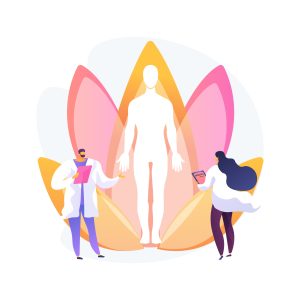 Age-related macular degeneration (AMD) is an eye disease that can blur your central vision. It occurs when aging damages the macula, the part of the eye that controls sharp, straight-ahead vision. The macula is part of the retina, the light-sensitive tissue at the back of the eye.
Age-related macular degeneration (AMD) is an eye disease that can blur your central vision. It occurs when aging damages the macula, the part of the eye that controls sharp, straight-ahead vision. The macula is part of the retina, the light-sensitive tissue at the back of the eye.
Age-related macular degeneration is a common condition and the most common cause of severe loss of eyesight among people 50 and older. It is important to realize that people rarely go blind from it. However, losing your central vision makes it harder to see faces, read, drive, or do close-up work like cooking or fixing things around the house.
There are two types of age-related macular degeneration, dry and wet.
Most people with age-related macular degeneration have dry AMD, also called atrophic AMD. This is when the macular gets thinner with age. Dry AMD happens in three stages:
Wet AMD, also called advanced neovascular AMD is a less common type of late AMD that causes faster vision loss. Dry AMD can turn into wet AMD at any stage, however, wet AMD is always late.
The most common symptoms of age-related macular degeneration can include:
- Blurry or fuzzy vision
- Difficulty recognizing familiar faces
- Seeing straight lines appearing wavy
- A dark, empty area or blind spot appears in the center of a person’s vision
The presence of tiny yellow deposits in the retina called drusen is one of the most common early signs of age-related macular degeneration. It can mean the eye is at risk of developing more severe age-related macular degeneration.
Several risk factors that can contribute to developing age-related macular degeneration include:
- Eating a diet high in saturated fat
- Smoking
- High blood pressure or hypertension
To diagnose age-related macular degeneration, an eye doctor will look at your medical history and perform an eye exam. They may also perform other tests to help diagnose AMD, including:
- A visual acuity test
- Pupil dilation
- Fluorescein angiography
- Amsler grid
Specific treatment for age-related macular degeneration is determined by your eye doctor based on:
- Your age, overall health, and medical history
- The extent and nature of the disease
- Your tolerance for specific medications, procedures, or low-vision therapies
- The expectations for the course of the disease
- Your opinion or preference
There is no current treatment for dry AMD, however, vision rehabilitation programs and low-vision devices can be used to build visual skills, develop new ways to perform daily living activities, and adjust to living with age-related macular degeneration.
The main treatment for wet AMD is an injection of medications called anti-VEGF agents. VEGF stands for vascular endothelial growth factor.
There is no cure for age-related macular degeneration. However, research shows that you may be able to lower your risk of AMD, or slow vision loss from AMD by:
- Quitting smoking
- Getting regular exercise
- Maintaining healthy blood pressure and cholesterol levels
- Eating healthy foods that include leafy green vegetables and fish
AMD happens very slowly in some people and faster in others. If you have early AMD, you may not notice vision loss for a long time. It is important to get regular eye exams to find out if you have AMD.
If you’re experiencing symptoms of dry or wet AMD, you can schedule an appointment at Jamaica Hospital Medical Center’s Ophthalmology Center by calling (718) 206-5900.
All content of this newsletter is intended for general information purposes only and is not intended or implied to be a substitute for professional medical advice, diagnosis or treatment. Please consult a medical professional before adopting any of the suggestions on this page. You must never disregard professional medical advice or delay seeking medical treatment based upon any content of this newsletter. PROMPTLY CONSULT YOUR PHYSICIAN OR CALL 911 IF YOU BELIEVE YOU HAVE A MEDICAL EMERGENCY.
 “If it wasn’t for Dr. McKenzie, I’d be dead”, is what Agostino Romano said after his experience at Jamaica Hospital Medical Center. Mr. Romano has been a patient of Dr. Katherine McKenzie for the last four years. He was first seen by her to treat perforated appendicitis in 2021. During this time, Dr. McKenzie observed that Mr. Romano wasn’t responding well to standard treatment. She suspected an underlying malignancy and investigated further. Dr. McKenzie diagnosed Mr. Romano with a rare and aggressive cancer called Burkitt’s lymphoma.
“If it wasn’t for Dr. McKenzie, I’d be dead”, is what Agostino Romano said after his experience at Jamaica Hospital Medical Center. Mr. Romano has been a patient of Dr. Katherine McKenzie for the last four years. He was first seen by her to treat perforated appendicitis in 2021. During this time, Dr. McKenzie observed that Mr. Romano wasn’t responding well to standard treatment. She suspected an underlying malignancy and investigated further. Dr. McKenzie diagnosed Mr. Romano with a rare and aggressive cancer called Burkitt’s lymphoma.









